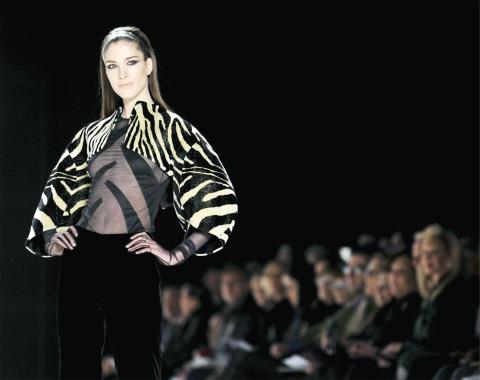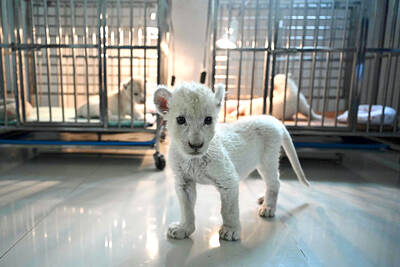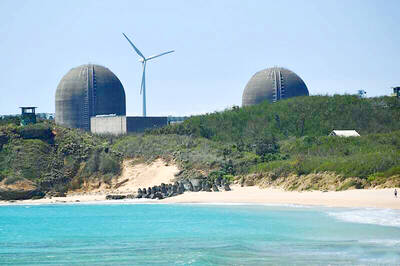You might expect a book on the designer Ralph Rucci to have a scholarly appreciation by the fashion historian Valerie Steele; swooning testimonials from society clients of Rucci’s like Deeda Blair and Susan Gutfreund; and romantic color plates of his high-wire dresses by a princeling photographer on the order of, say, Patrick Demarchelier.
But Autobiography of a Fashion Designer: Ralph Rucci, a US$195 slipcased and cotton-clothbound doorstop from the upstart art-book publisher Bauer and Dean, nominally by Rucci, is a pie in the face of conventional designer monographs. There are no baby pictures, no timeline, no biography (Rucci, 54, is the son of a Philadelphia butcher, but you won’t learn that here). There are nine pictures of his dog, at least five pictures of his dog’s toys, but no page numbers.
The press run of 3,000 coincides with the 30th anniversary of Rucci’s company, Chado Ralph Rucci, as well as the news that after four years of production, the documentary A Quiet American: Ralph Rucci & Paris is to be screened at New York Fashion Week next month.

Photo: EPA
The film’s director, Christian Leigh, is a former curator whose unpaid bills at the 1993 Venice Biennale led to works by Louise Bourgeois, Roy Lichtenstein and others being held in storage by creditors for about five years. Leigh disappeared during this time.
An exhibition, Notorious (Christian Leigh), an exploration of his career, is currently at the Castillo/Corrales gallery in Paris. “Leigh has made a habit of burning bridges, vanishing overnight and of reinventing himself anew in a different milieu,” the gallery says on its Web site, adding that Leigh’s biographies include trails of “angry creditors, ripped-off artists, bamboozled collaborators.”
It remains to be seen whether the Rucci project will redeem Leigh’s reputation. Reached at home in London, Leigh denied cheating any artists. “I felt I did everything I could,” he said, then, “Well, maybe not.”
“I don’t really accept that I disappeared. Most people could reach me if they really wanted to.”
He proclaimed himself a great fan of Rucci. “I didn’t know him, but greatly admired his work,” Leigh said. “He’s one of the great artists working today. If he wants to work on one dress for 16 weeks, he won’t compromise.”
He suggested his documentary had equal integrity. “It’s not gossipy or bitchy,” Leigh said. “It’s not ‘How hissy fits make fashion,’ like the Valentino movie.”
Until A Quiet American is unveiled, there is Autobiography of a Fashion Designer, which — depending on how one looks at it — is either the ultimate tome for fashion insiders or maddeningly presumptive, with names dropped and left floating without explanation.
Rucci, the only American designer besides Mainbocher ever to show in Paris with the blessing of the French haute couture sanctioning body, and one of the few not to have succumbed to mass production, said: “I don’t have much perspective on myself. The book and movie are like psychological blackboards.”
As he tweaked sketches for his new furniture collection for Holly Hunt in his SoHo office recently, Rucci was surrounded by talismans: a liquid Joe Eula drawing of his old boss Halston in a fitting with Jacqueline Onassis, another by Kenneth Paul Block of Diana Vreeland in a seal coat with a stand-away Balenciaga collar.
Rucci said he gave Baldomero Fernandez, the book’s photographer, carte blanche, “drawing the line only at a basket of my underwear.” Gutfreund, he added: “shamed me into redoing my apartment. She was over one day and asked, ‘How can you expect a woman to sit on that?’ She was gesturing to a Mies chaise.”
Indeed, more than a third of the volume is taken up by photographs of Rucci’s aerie in a prewar building on New York’s East 72nd Street, sumptuously decorated by Gutfreund with silk organdy lampshades, leather walls embossed at breath-catching expense in a traditional Chinese thatched motif and a hand carved cocobolo-wood dry bar whipped up by Renzo Mongiardino, the maestro of Italian interior design, in the shape of the Duomo in Milan. A wraparound terrace is planted with a forest of weeping white birches.
There are also many photographs of commonplace details: a bucket of cleaning supplies, his television remote on a silver tray, a bunch of overripe bananas. Inside Rucci’s refrigerator are Fage yogurt, Red Jacket Orchards applesauce, Muscle Milk and a partly zested lemon.
“The model is Autobiography: Sol LeWitt 1980, with its purposely bad shots of everything from toilets to toolboxes,” said Beth Daugherty, the publisher of Bauer and Dean. “Ralph’s book wasn’t styled. The pictures are intentionally raw.”
Daugherty said she was vexed that the book, her first major title, has come out just as Leigh’s film, which she said she was unaware of until a few weeks ago, is being chatted about. Judging from a 31-minute rough cut of what the director said was an 89-minute movie, it is straightforward, if rather fawning.
In it, Tatiana Sorokko, who once modeled for Rucci and is now a client, is seen defending the stupendously high cost of his dresses, confected of duchess satin encased in chinoiserie threadwork, crepe braided to resemble the human spine and chiffon hand sewn with tiny bits of leather to evoke the crackled glaze of Chinese export porcelain. His ready-to-wear starts at US$5,000; couture, US$7,000.
It’s “not about the price,” Sorokko insists in the film. “You’re paying for his knowledge of fashion history and his intelligence.”
In the words of a patternmaker: “He knows what each cloth asks to be.”
The weaving together of the film is taking too long for Rosina Rucci, Rucci’s sister and communications director, who said the Rucci company had invested US$40,000 in the project and has expressed irritation with its slow progress.
“Is there a complete film?” she said. “After four years, we still don’t know.”
But Rucci, at least, is willing to wait.
“When I met him I was totally mesmerized by his fanaticism,” he said, regarding Leigh. “Listen, I know this man’s heart, and I also see the demons. If there’s a disconnect, it’s not for me to judge. I choose to support him. Christian’s logic I’ve learned not to touch. Like Mrs Vreeland, it’s all hieroglyphics.”

No one saw it coming. Everyone — including the Chinese Nationalist Party (KMT) — expected at least some of the recall campaigns against 24 of its lawmakers and Hsinchu Mayor Ann Kao (高虹安) to succeed. Underground gamblers reportedly expected between five and eight lawmakers to lose their jobs. All of this analysis made sense, but contained a fatal flaw. The record of the recall campaigns, the collapse of the KMT-led recalls, and polling data all pointed to enthusiastic high turnout in support of the recall campaigns, and that those against the recalls were unenthusiastic and far less likely to vote. That

Behind a car repair business on a nondescript Thai street are the cherished pets of a rising TikTok animal influencer: two lions and a 200-kilogram lion-tiger hybrid called “Big George.” Lion ownership is legal in Thailand, and Tharnuwarht Plengkemratch is an enthusiastic advocate, posting updates on his feline companions to nearly three million followers. “They’re playful and affectionate, just like dogs or cats,” he said from inside their cage complex at his home in the northern city of Chiang Mai. Thailand’s captive lion population has exploded in recent years, with nearly 500 registered in zoos, breeding farms, petting cafes and homes. Experts warn the

A couple of weeks ago the parties aligned with the People’s Republic of China (PRC), the Chinese Nationalist Party (KMT) and the Taiwan People’s Party (TPP), voted in the legislature to eliminate the subsidy that enables Taiwan Power Co (Taipower) to keep up with its burgeoning debt, and instead pay for universal cash handouts worth NT$10,000. The subsidy would have been NT$100 billion, while the cash handout had a budget of NT$235 billion. The bill mandates that the cash payments must be completed by Oct. 31 of this year. The changes were part of the overall NT$545 billion budget approved

The unexpected collapse of the recall campaigns is being viewed through many lenses, most of them skewed and self-absorbed. The international media unsurprisingly focuses on what they perceive as the message that Taiwanese voters were sending in the failure of the mass recall, especially to China, the US and to friendly Western nations. This made some sense prior to early last month. One of the main arguments used by recall campaigners for recalling Chinese Nationalist Party (KMT) lawmakers was that they were too pro-China, and by extension not to be trusted with defending the nation. Also by extension, that argument could be